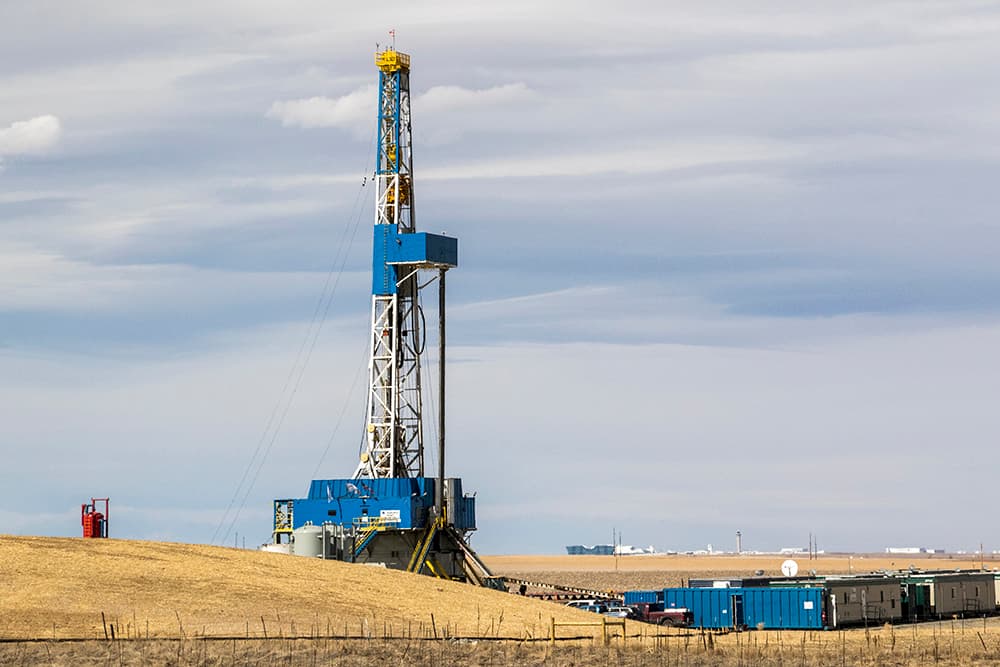For a few days this year, it looked like northeast Denver might see some of the first oil and gas drilling sites in the city's recent history.
A state board was considering a proposal to lease out land for potential drilling near the Rocky Mountain Arsenal, including around Stapleton and Green Valley Ranch.
It didn't happen, but it got us thinking: What would it take for fracking and other types of drilling to reach the city's borders?
"There really hasn't been anything in Denver County," said Bernadette Johnson, vice president of market intelligence for DrillingInfo.
Instead, the closest activity is clustered to the northeast, especially around Weld County. The city of Broomfield also has conditionally approved a plan to drill six well sites, and some operations have cropped up east of Aurora.
But oil and gas companies could draw closer to Denver and Aurora if prices continue to rise.
The entire metro area falls within the same "Denver Julesburg Basin" as Colorado's main drilling fields, and some companies are nibbling at the edges of Denver and its suburbs. A handful of operators already have permits for the area east of Aurora and south of the airport, and one rig operating here, according to data provided by DrillingInfo.
"There are some promising wells down there, but there's not a ton yet," Johnson said.
The question is what price-point would drive drillers closer to the city. Oil prices have trended upward over the last year, currently sitting around $65 a barrel -- but that's far short of the $100-plus prices we saw in 2014.
"The decision to drill ... it all comes down to breakeven economics," Johnson explained. "They're looking at their portfolios. They're trying to figure out what types of wells they can drill with today's prices."
Different types of subsurface geology can affect the cost of drilling. The layers of rock that hold extractable oil are present across the Front Range, but the number of resources and the ease of extraction can vary greatly.
Weld County and Greeley have favorable drilling conditions, and their rural nature made it easier for drillers to get established, according to geologist Ronald Pritchett. Meanwhile, drillers still have relatively little information about the costs and potential profits for sites near Denver, because there has been little activity there, Johnson said. So far, Denver's eastern neighbors aren't seen as very economical places to operate, according to Johnson.
"That's not been, so far, focused on Adams County, Arapahoe County," she explained.
However, the area does have some favorable factors for drillers. "Outside of Denver, you have the roads, you have the highway. You're generally connected to the grid," she said.
And there has already been some interest in Denver itself.
The Colorado State Land Board controls the rights to hundreds of acres of the subsurface of northeast Denver, along with some surface land.
In January, Pritchett asked the state board to consider leasing out the underground area around the Northfield section of Stapleton for oil and gas development. He also nominated a tract near a Denver Water reservoir in Adams County and one within Rocky Mountain Arsenal.
State staffers also recommended that the board lease out acreage on the western side of Green Valley Ranch, near the intersection of Tower Road and Green Valley Ranch Boulevard.
The housing development around those sites could make extraction tricky, but state staffers said that horizontal drilling could allow companies to reach oil and gas from afar. Leasing state mineral rights produces money for schools.
"It’s really kind of a long shot, but I think it’s a resource that is there and is accessible, if we can clear away the politics," said Pritchett, who estimated that the equivalent of 170 million barrels of oil and gas could be extracted from the Arsenal and the adjacent land.
"I think it can be done safely and to the benefit of many people," he said.
His proposal resulted in nearly 500 emails of protest to the land board in a matter of days, many related to health and noise questions. Researchers have found numerous potential links between fracking chemicals and potential health consequences. Previous drilling to bury hazardous waste on the Arsenal also was linked to earthquake activity, though Pritchett said that could be avoided with shallower, safer operations.
The board ultimately rejected all of the tracts near Denver. Extraction on the Arsenal is not allowed under a longstanding contract.
And, even if the auction had been allowed, there's no guarantee that drilling would happen. Drilling within the Arsenal would have required access to federal lands, Pritchett said. While Interior Sec. Ryan Zinke has called for greater commercialization of federal lands, there's no sign of change at the Arsenal
So, for now, extraction remains far outside the city proper. But the continued evolution of drilling technology is opening wider and wider swaths. A single eight-acre site, he said, could allow drillers access to a two-mile radius of minerals, assuming they have the rights.
"Now, with the technical improvements, it’s possible to backtrack and get closer to the city and declare fair volumes of leases and property rights as viable," he said. He thinks that drillers also could work with housing developers and owners to negotiate drilling rights -- but he doesn't think it will happen anytime soon.
If it does come closer, the city could find itself in the same discussions about health, safety and economics that have played out across northern Colorado.











